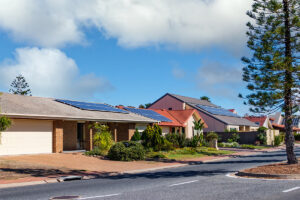- A new report by the McKell Institute criticises government inaction to halt the increase of wholesale gas prices.
- It blames the export of LNG for making gas powered plants at home more expensive to run.
- Many consumers are also unable to negotiate long term contracts with suppliers.
- Government reforms instigated last year are insufficient to put downward pressure on prices.
- Wind and solar energy are predicted to be the answer to rising energy prices.
According to a new report by the McKell Institute (an independent, not-for-profit, public policy institute), if the Government doesn’t intervene in the gas market, the impact of wholesale gas prices on average household power bills in Queensland, New South Wales and Victoria could be significant.
Ironically, Australia is expected to overtake Qatar as the world’s largest LNG exporter in 2018, but gas shortages at home to run power plants are boosting local electricity prices to some of the highest in the world.
The report states that State and Federal governments have “enabled major gas producers to develop Australia’s natural gas fields without properly ensuring their committed export contracts would not drain supply out of the domestic market.”
One of the issues facing gas consumers and electricity consumers is an ability to negotiate affordable, long-term contracts with suppliers. This puts them at the mercy of inflating prices. Compounding the problem is the disuse of coal by most generation businesses making consumers more reliant on gas powered plants. Older coal-fired power stations, such as the Northern Power Station in South Australia and the Hazelwood Power Station in Victoria, have been closed.
In June last year, the Federal Government announced reforms intended to address domestic supply issues – the Australian Domestic Gas Security Mechanism (ADGSM). However, the McKell report states the reforms to federal gas policy have not translated into price reductions and the ADGSM is insufficient to “ensure supply over the long term, or put downward pressure on prices.”
“While the introduction of the ADGSM is one step towards guaranteeing more certainty in the Australian domestic gas market, it is likely insufficient in providing long-term certainty, and is certainly not a panacea for escalating wholesale gas prices on the East coast,” states the report.
In 2017, says the McKell report, households in New South Wales, Queensland and Victoria approximately paid $151, $175, and $134 more respectively for their annual power than what the Australian Competition and Consumer Commission (ACCC) forecasted was reasonable.
If price hikes continue, McKell forecasts the increased annual electricity costs for New South Wales, Queensland and Victoria by 2019 will be $434, $312 and $253 more respectively.
This is at odds with the Australian Energy Market Commission’s outlook published in December 2017 which believes that prices will drop in the next two years in these three States because of the increased usage of wind and solar power based generation. These, it says, will put downward pressure on wholesale prices with lower cost renewables being the answer to rising energy prices.
For consumers who are concerned about the current state of power prices, installing solar is a great solution and can dramatically reduce bills while paying for itself in just a few years. Solar Market helps by arranging for 3 quotes from installers in your local area.










